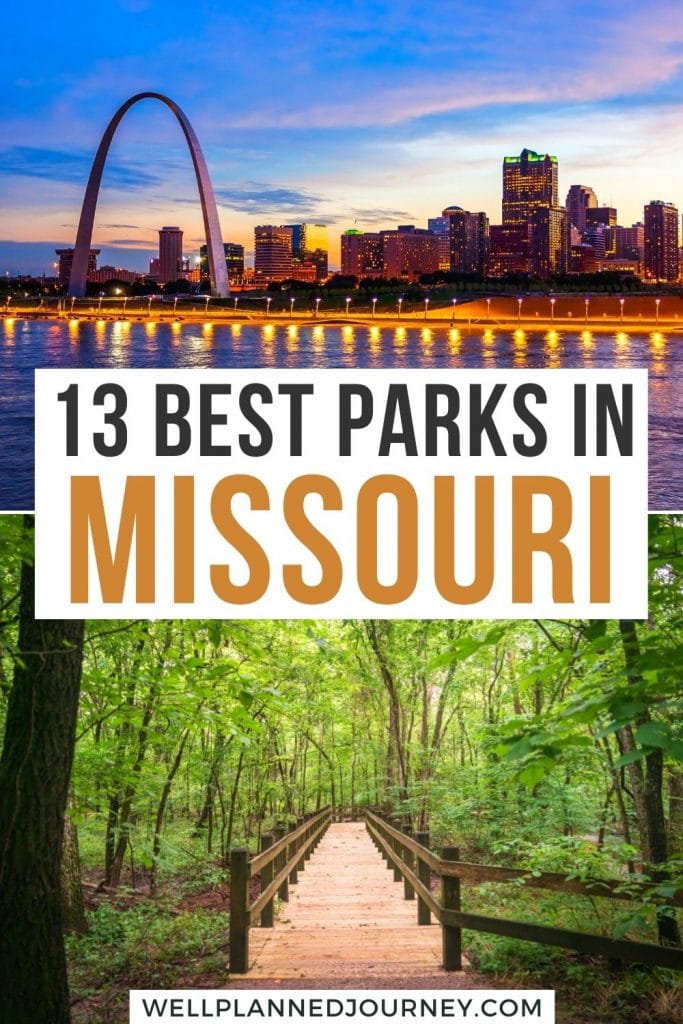Missouri is filled with beautiful landscapes in the heart of America. It’s known as the gateway to the west, memorialized by the Gateway Arch in St. Louis. But beyond the big city, there are rolling hills, flowing rivers, and immense history and culture.
But did you know Missouri has 13 national parks?
From unique inner-city parks to scenic riverways to historical sites, the national park sites in Missouri are plentiful. So you can immerse yourself in this midwestern state’s history, natural beauty, and culture.
This guide covers the best national parks in Missouri, complete with each park’s highlights and must-see destinations. You’ll love this post if you’re looking to check every Missouri park off your bucket list!
Are you looking to visit all 63 USA national parks? Don’t miss this national park checklist!
This post may contain affiliate links, where I may receive a small commission at no additional cost to you. Read more in this disclosure policy.
Map of Missouri National Parks
Missouri’s national parks are spread throughout the state. The seven national parks within Missouri (excludes the multi-state national historic trails discussed later in this post) can be seen on the map here.
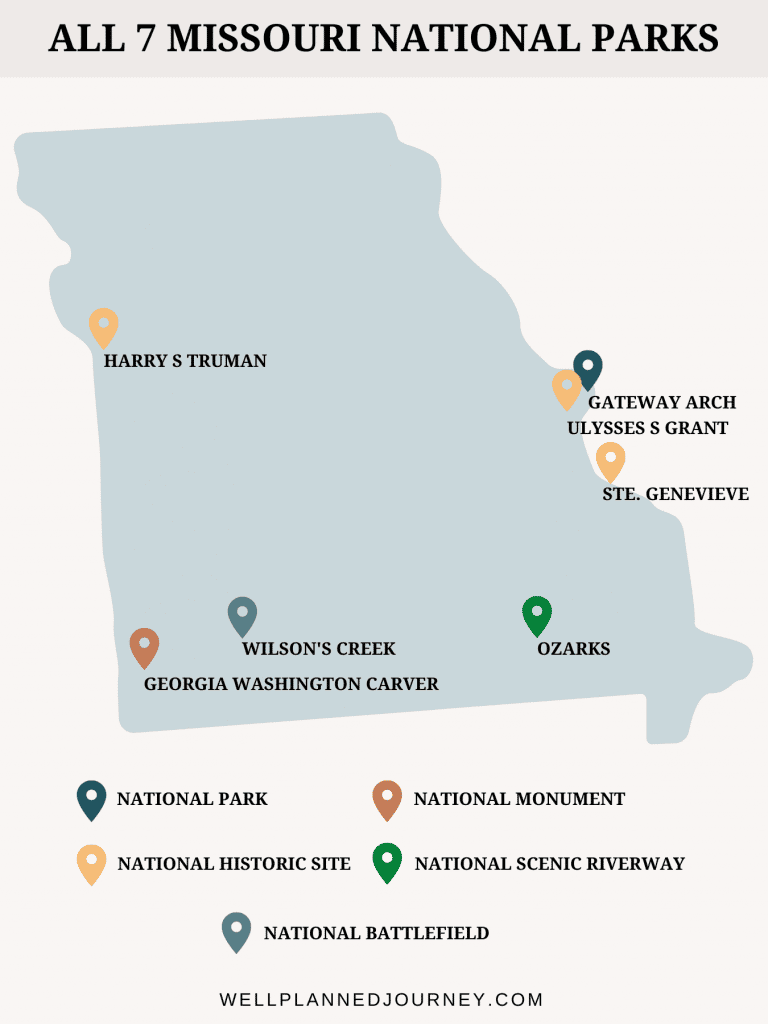
National Parks in Missouri
There are several parks in Missouri, ranging from official “national parks” to national monuments to scenic riverways and national historic sites. Keep reading to discover the best of these national parks in Missouri.
You can read the comprehensive list of every national park in Missouri here.
Are you planning a national park trip but don’t know where to start? Get my free 28-page national park ebook where I break down everything you need to know to visit all 63 USA national parks.
Download your free ebook here.
1. Gateway Arch National Park
- Location: St. Louis, Missouri
- Size: 91 acres
- Annual Visitors: 1,145,081
- Founded: 2018
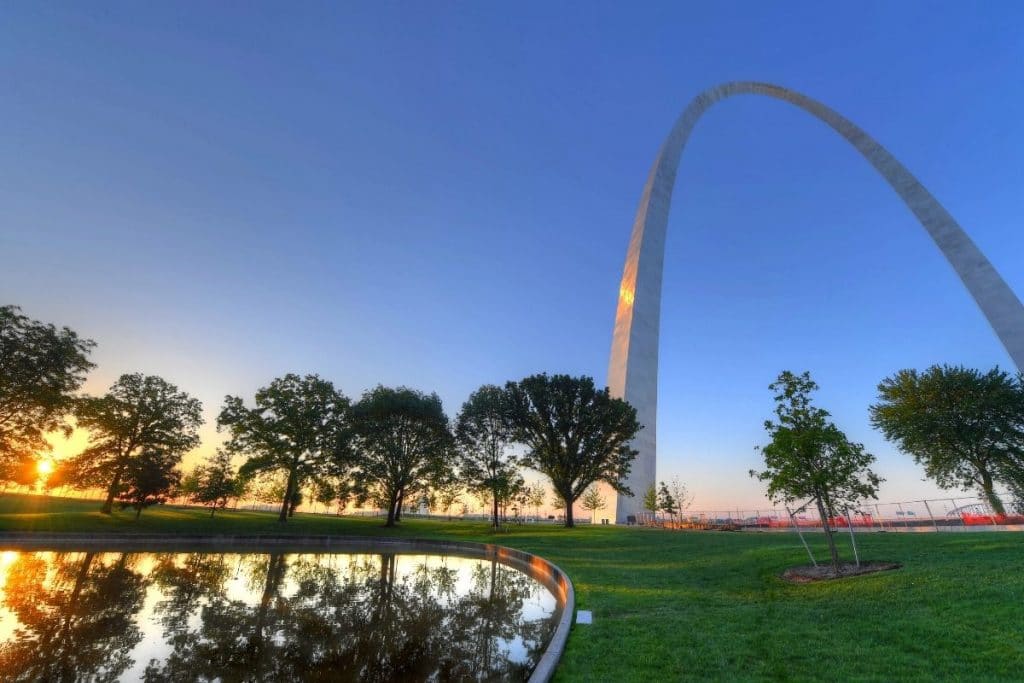
Sitting on the edge of the Mississippi River in downtown St. Louis, Gateway Arch National Park is rich with the history of Missouri’s role in the westward expansion of the United States in the 1800s as the starting point of the Lewis and Clark Expedition.
At the park’s heart, you’ll find the namesake Gateway Arch, memorializing Thomas Jefferson’s role in the Louisiana Purchase.
Before being designated a national park, the park was previously known as the Jefferson National Expansion Memorial.
The Gateway Arch stands at over 630 feet, making it the tallest structure in Missouri. A tram to the top provides incredible views from the observation room. Visiting the top of the arch is a must for any St. Louis itinerary.
The park also commemorates the history of Dred Scott, an enslaved person who sued for his freedom at the Old Courthouse here. The ruling was unsuccessful for Scott and became one of the catalysts for the Civil War a few years later. The museum here details the historic trial with informative exhibits.
Read more about Gateway Arch National Park.
2. George Washington Carver National Monument
- Location: Diamond, Missouri
- Size: 240 acres
- Annual Visitors: 25,838
- Founded: 1943

George Washington Carver was one of the most prominent black scientists of the 20th century, leading agricultural research and innovation. Born into slavery during the Civil War, Carver faced immense adversity to become one of the most notable historical figures and inventors in the United States.
This national monument memorializes his life and lasting impact on American farming and the economy. In addition, it was the first national monument to recognize the life of an African American.
The historic monument preserves the Carver family home and cemetery in Diamond, Missouri. The 240 acres of land features rolling hills, miles of trails, museums, and interactive displays to learn more about the life of George Washington Carver.
Read more about Georgia Washington Carver National Monument.
3. Harry S. Truman National Historic Site
- Location: Independence, Missouri
- Size: 0.8 acres
- Annual Visitors: 12,148
- Founded: 1985
Harry S. Truman was born in Lamar, Missouri, and served as the 33rd president of the United States from 1945 to 1953. He became president at the end of World War II, following the death of Franklin D. Roosevelt.
He was the first president from Missouri and made lasting impacts like the establishment of NATO.
The Truman National Historic Site in Independence, Missouri, preserves the Truman Home and the Truman Farmhouse. Visitors can experience Truman’s simple, humble life before being elected as President. After his presidency, Truman returned and lived out his life with his wife, Bess Wallace.
Read more about Harry S Truman National Historic Site.
4. Ozark National Scenic Riverways
- Location: Shannon, Carter, Dent, and Texas Counties, Missouri
- Size: 80,000 acres
- Annual Visitors: 1,328,773
- Founded: 1964
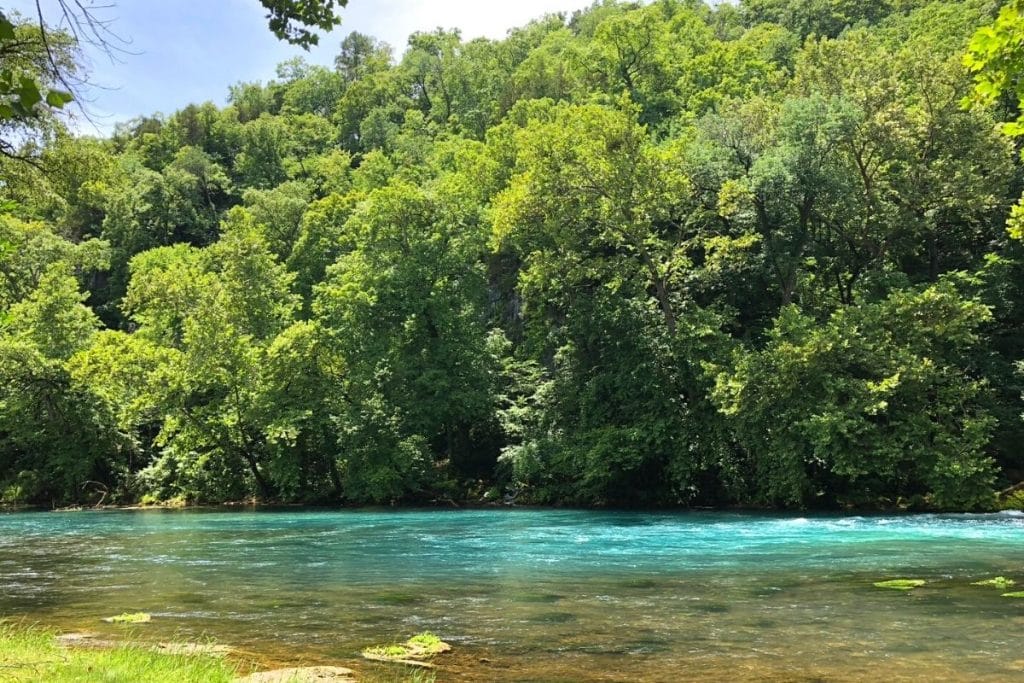
Ozark National Scenic Riverways is the first national park established to protect a river system. This landmark park preserves 134 miles of two rivers: the Current River and the Jacks Fork River.
The park is known for its beautiful natural landscape, home to 400 species of animals and thousands of vegetation species. With 80,000 acres of protected land, there’s plenty to explore on the park’s expansive hiking trails.
Visitors can enjoy swimming, boating, canoeing, kayaking, and fishing on the pristine, calm waterways. Beyond the rivers, the park is also home to springs, caves, historic sites, and trails. For dedicated hikers, the Ozark Trail is a popular long-distance hike.
The best time to visit is in the summer when the weather is warm. Visitors can stop by Alley Mill to learn more about the park and get information during the summer months.
Read More about Ozark National Scenic Riverway.
5. Ste. Genevieve National Historical Park
- Location: Ste. Genevieve, Missouri
- Size: 1,200 acres
- Founded: 2020
Ste. Geneviève was the first permanent European settlement in Missouri, established in 1750.
Agricultural prospects brought French Canadian settlers to the area along the Mississippi River. As a result, several of the homes and historic sites in the settlement serve as excellent examples of French colonial-style architecture.
The area served as the capital of French Louisiana back in the 18th century and was a hub of French trading of furs and other goods before Missouri joined the United States.
This park is one of the newer national parks and the most recent in Missouri. Here visitors can take ranger-led tours of the historic homes, like the Jean Baptiste Vallé House and Bauvais-Amoureux House.
Read more about Ste. Genevieve National Historic Park.
6. Ulysses S. Grant National Historic Site
- Location: Grantwood Village, Missouri
- Size: 20 acres
- Annual Visitors: 27,823
- Founded: 1986
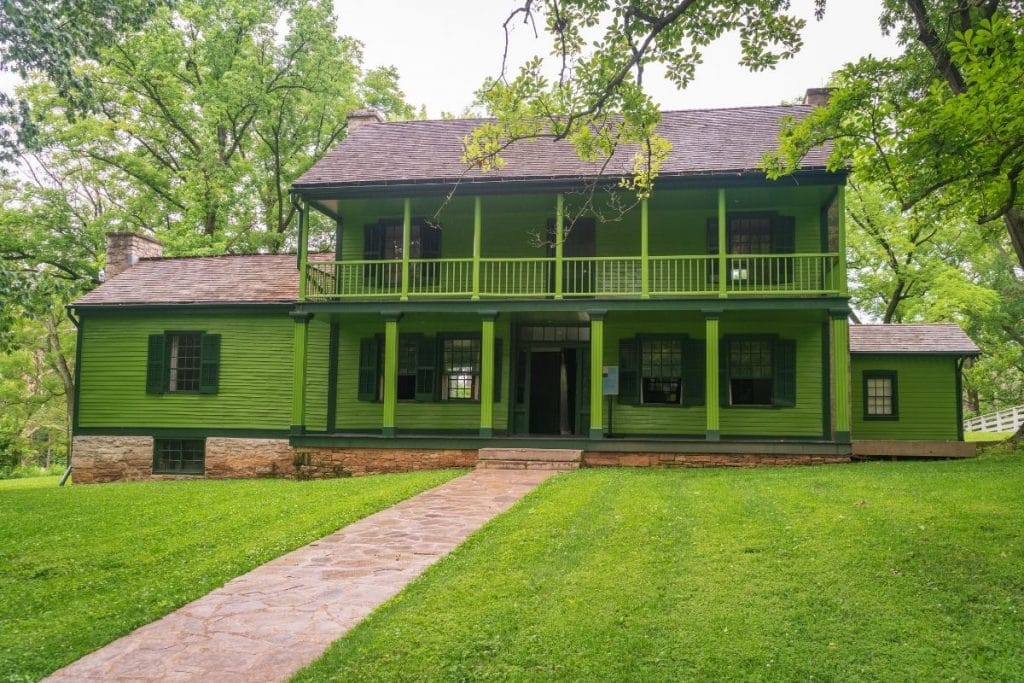
Ulysses S. Grant was the 18th president of the United States and the general who led the Union to victory in the Civil War. The national historic site in Missouri recognizes Grant’s life and achievements during his military career and presidency.
The site preserves the family home, named White Haven, of Grant’s wife, Julia Dent. In addition, the property includes a barn and a shed, thought to have been used as slave quarters.
Before the Civil War, Grant lived here with his wife’s family and a large enslaved workforce working on their plantation.
At the Grant National Historic Site, you can learn more about White Haven, including its complicated history with slavery. It is believed that Grant’s direct experience with slavery inspired him to fight for freedom with the Union and work to free his family’s slaves.
Read more about Ulysses S Grant National Historic Site.
7. Wilson’s Creek National Battlefield
- Location: Republic, Missouri
- Size: 2,408 acres
- Annual Visitors: 271,245
- Founded: 1960
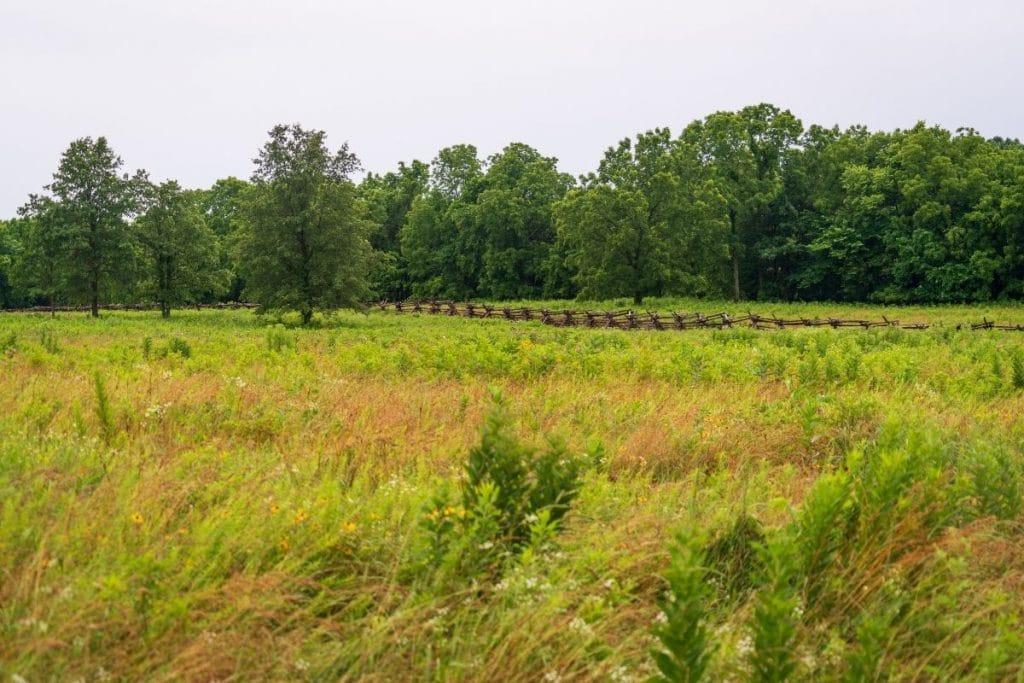
Missouri played a pivotal role in the Civil War. Wilson’s Creek was the site of the first major Civil War battle fought west of the Mississippi. The battle took place on August 10, 1861, and led to the death of a Union general, Nathaniel Lyon, and a Confederate victory.
This national battlefield shares the importance of the Civil War in the Trans-Mississippi West, an area that is often ignored or overshadowed.
Today, visitors can learn more by taking a narrated 5-mile scenic drive, visiting the Ray House, and “Bloody Hill”, the battle site.
Read more about Wilson’s Creek National Battlefield.
National Historic Trails in Missouri
In addition to the national parks in Missouri, several national historic trails pass through the state. These trails span multiple states and commemorate some of the most critical multi-state historical paths and routes.
8. California National Historic Trail
The California National Historic Trail follows the route of 250,000 emigrants who journeyed to California during the Gold Rush in the 1840s and 1850s. The trail is over 5,000 miles long, stretching across ten states from Missouri to California.
Today, hikers can visit segments of the trail to hike and discover the history of those that traveled west with hopes of finding gold. In Missouri, you can see the start of the California National Historic Trail in either St. Joseph or Kansas City.
Read More: 16 Best National Parks in California
9. Lewis & Clark National Historic Trail
The Lewis & Clark National Historic Trail follows the roughly 4,900-mile path from Pittsburgh to the Pacific Ocean in Astoria, Oregon. The trail passes through sixteen states, including Missouri, the gateway to the west after the Louisiana Purchase.
Today, the trail is filled with hiking opportunities, informative displays, visitor centers, and points of interest. In Missouri, the trail passes through Ste. Genevieve and St. Louis, continuing west to Kansas City, then north towards South Dakota along the Missouri River.
10. Oregon National Historic Trail
The Oregon National Historic Trail, more commonly known as the “Oregon Trail”, starts in Missouri and spans more than 2,000 miles westward to Oregon, passing through six states.
The rugged trail was the main route for migrants to the west coast in the 1800s, followed by those looking for a new life and farmland out west.
Today, the Oregon National Historic Trail segments are open for hiking and other educational activities. You can learn about the journey of those that followed the Oregon Trail and the history of the areas they passed through.
These sites include the Wayne City Landing and the Raytown Historical Society Museum in Missouri.
11. Pony Express National Historic Trail
The Pony Express National Historic Trail is another pathway that began in Missouri, the true gateway to the west. Spanning from St. Joseph, Missouri, to San Francisco, California, this route covers 1,800 miles and eight states.
The trail marks the route that young mail carriers with the Pony Express Service in the 1800s rode to facilitate communications between the east and west before the invention of the telegraph.
It’s said that riders could cover the distance in only ten days!
In Missouri, visitors can stop at the Pony Express Museum in St. Joseph to learn how the Pony Express revolutionized communications and mail delivery in the United States.
12. Santa Fe National Historic Trail
The Sante Fe National Historic Trail follows the important trail from Missouri to New Mexico established during the 1800s. Also called the Great Prairie Highway, this route was vital for trading in the southwest.
It covers 1,200 miles and five states, spanning from Boonville, Missouri, along with the Lewis & Clark Trail to Sante Fe, New Mexico.
The Sante Fe Trail has a clouded history with the indigenous Comanche people and had importance during the American Civil War and Mexican-American War.
Today, visitors can learn more about the past and hike and drive sections of the trail across several states.
13. Trail of Tears National Historic Trail
The Trail of Tears National Historic Trail marks the route followed by the indigenous Cherokee people who were forcibly removed from their homes and relocated to the Indian Territory further west.
In the late 1830s, the Cherokee people moved on foot, horse, wagon, and boat to what is now Oklahoma.
The Trail of Tears spans several states, from North Georgia to eastern Oklahoma, passing through southern Missouri and the Ozarks. The route memorializes the atrocities committed against the indigenous people in America by the Indian Removal Act.
Today, the trail remembers the thousands of Cherokee that died walking this route. Visitors can walk parts of the Trail of Tears to remember the cruelty and injustice done to the Cherokee people.
This park reminds us that learning from our past mistakes can help us grow into a better future.
Frequently Asked Questions about the Best National Parks in Missouri
Does Missouri have any national parks?
There are seven national parks in Missouri, including Gateway Arch National Park (previously called Jefferson National Expansion Memorial). In addition to the national parks, monuments, and historic sites, six national historic trails pass through Missouri.
How many National Parks are in Missouri?
There are seven official national parks in Missouri, plus six national historic trails. However, the only park holding the “national park” title is the Gateway Arch National Park in Missouri, a former national memorial.
What are the 7 national parks in Missouri?
The seven national parks in Missouri are:
- Gateway Arch National Park
- George Washington Carver National Monument
- Harry S. Truman National Historic Site
- Ozark National Scenic Riverways
- Ste. Genevieve National Historic Park
- Ulysses S. Grant National Historic Site
- Wilson’s Creek National Battlefield
What is the only national park in Missouri?
The only official national park in Missouri is Gateway Arch National Park, formerly known as the Jefferson National Expansion Memorial. This park was designated as one of the 63 US national parks in 2018 after being on the National Registry of Historic Places since 1966.
Is the Gateway Arch a national park?
The Gateway Arch became the Gateway Arch National Park in 2018 after previously being designated as a national memorial for over 50 years. Today, the Gateway Arch is protected by the National Park Service and is one of America’s 63 national parks.
What national monument is in Missouri?
The only national monument in Missouri is the George Washington Carver National Monument. This historic landmark preserves the legacy of George Washington Carver, one of the most influential black innovators of the 20th century. It was the first national monument dedicated to an African American person.
Are you planning a national park trip but don’t know where to start? Get my free 28-page national park ebook where I break down everything you need to know to visit all 63 USA national parks.
Download your free ebook here.
Final Thoughts on Missouri National Parks
Missouri is home to beautiful landscapes and historic educational sites, appealing to nature lovers and history buffs. This guide covers all the best parks in Missouri to help you check them off your bucket list!
This is the list of national parks in Missouri:
- Gateway Arch National Park
- George Washington Carver National Monument
- Harry S. Truman National Historic Site
- Ozark National Scenic Riverways
- Ste. Genevieve National Historic Park
- Ulysses S. Grant National Historic Site
- Wilson’s Creek National Battlefield
- California National Historic Trail
- Lewis & Clark National Historic Trail
- Oregon National Historic Trail
- Pony Express National Historic Trail
- Sante Fe National Historic Trail
- Trail of Tears National Historic Trail
Are you looking to visit all 63 USA national parks? Don’t miss this national park checklist!
Don’t Forget to Save This Post on Pinterest
